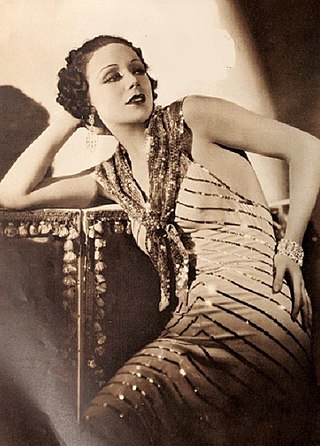
Jane the Virgin is a 2002 Venezuelan telenovela written by Perla Farías and produced by RCTV. It was distributed worldwide by RCTV International.

Mateo is a 1937 Argentine crime drama film directed by Daniel Tinayre, which he adapted from the play by Armando Discépolo. Starring Luis Arata, Enrique Santos Discépolo, José Gola and Alita Román, it was the first successful film of Tinayre's.

Tony D'Algy was a Portuguese film actor. He appeared in 57 films between 1924 and 1949, including The Boob, a silent comedy where Joan Crawford makes one of her first appearances. He was born in Luanda, Angola, and died in Lisbon, Portugal. He was the older brother of actress Helena D'Algy.
Marielena is a Spanish-language telenovela written by Delia Fiallo. It premiered on Telemundo in 1992, and starred Lucía Méndez and Eduardo Yáñez. The telenovela was originally aired in a few dozen countries around the world.

Rosita Moreno was a Spanish film actress who worked in cinema in Hollywood, Argentina, Mexico, and in her native Spain.
The Good Love is a 1963 Spanish drama film directed by Francisco Regueiro. It was entered into the 1963 Cannes Film Festival. The plot follows a young couple spending the day in Toledo.

Helena D'Algy (1939-1991) was a Portuguese stage and film actress. D'Algy performed on Broadway in the Ziegfeld Follies of 1923 and The Sex Fable (1931). She appeared in 20 films, the majority in Hollywood during the silent era. Her career began to falter following the introduction of sound. D'Algy later starred in the Spanish-language box office hit Suburban Melody (1933), her last known film role. She was the sister of actor Tony D'Algy. She was last seen in a 1991 documentary.

Suburban Melody is a 1933 American pre-Code musical film directed by Louis J. Gasnier and starring Imperio Argentina, Carlos Gardel and Vicente Padula.
The Holy Crown is a 1947 Spanish-Portuguese historical drama film starring Maruchi Fresno, António Vilar and Luis Peña. Separate Spanish and Portuguese versions were filmed with the Spanish directed by Rafael Gil and the Portuguese by Henrique Campos and Aníbal Contreiras. It was part of a popular group of Spanish costume films made in the late 1940s.
The Party Goes On is a 1948 Spanish drama film directed by Enrique Gómez and starring Antonio Casal, María Isbert and Juan Vázquez. It is set in the world of bullfighting
Whirlwind is a 1941 Spanish comedy film directed by Luis Marquina and starring Estrellita Castro, Manuel Luna and Tony D'Algy. It was made by Spain's largest film company of the era CIFESA.

White Mission is a 1946 Spanish drama film directed by Juan de Orduña and starring Manuel Luna, Jorge Mistral and Fernando Rey. The film was shot on location in Spanish Guinea and in a Spanish studio. The film's sets were designed by Sigfrido Burmann and Francisco Canet.

A Lucky Man is a 1930 American comedy film directed by Benito Perojo and starring Roberto Rey, María Luz Callejo and Valentín Parera. It is a Spanish-language film made for the Hollywood company Paramount Pictures at their Joinville Studios in Paris. Separate versions were also made in French and Swedish. The French version is known as A Hole in the Wall.
A Race of Noblemen is a 1927 Spanish silent film directed by and starring Tony D'Algy. It was shot at the Berlin studios of UFA as part of a co-production agreement.
The Pure Truth is a 1931 American comedy film directed by Florián Rey and Manuel Romero and starring José Isbert, Enriqueta Serrano and Manuel Russell.

The White Dove is a 1942 Spanish musical drama film directed by Claudio de la Torre and starring Juanita Reina, Tony D'Algy and Antonio Huelves. It was remade in 1955 as It Happened in Seville with Reina again in the role of Esperanza.
A Gentleman in Tails is a 1931 American comedy film directed by Roger Capellani and Carlos San Martín and starring Roberto Rey, Gloria Guzmán and Rosita Díaz Gimeno. It is the Spanish-language version of the 1927 film Evening Clothes. It was made by Paramount Pictures at the Joinville Studios in Paris. A French-language version The Man in Evening Clothes was also released the same year.

The Man Who Wanted to Kill Himself is a 1970 Spanish comedy film directed by Rafael Gil and starring Tony Leblanc, Antonio Garisa and Elisa Ramírez. It is a remake of the 1942 film of the same title.
Between Night and Day is a 1932 British mystery film directed by Albert de Courville and Fernando Gomis. It was made at Walton Studios as the Spanish-language version of the British mystery film 77 Park Lane, which was based on the 1928 play by Walter C. Hackett. A separate French-language film 77 Rue Chalgrin was also released. Such multiple-language versions were common during the early years of sound. The only actor appearing in the film with a career in the English-speaking world was Helena D'Algy.

Let's Get Married is a 1931 French comedy film directed by Louis Mercanton and starring Alice Cocéa, Fernand Gravey and Marguerite Moreno. It was made at the Joinville Studios in Paris by the French subsidiary of Paramount Pictures as a remake of the company's 1930 film Her Wedding Night. Such multiple-language versions were common in the early years of sound film before dubbing became commonplace.











